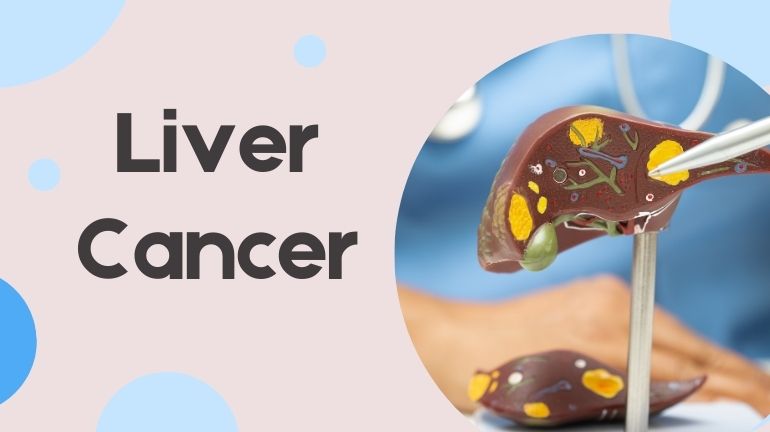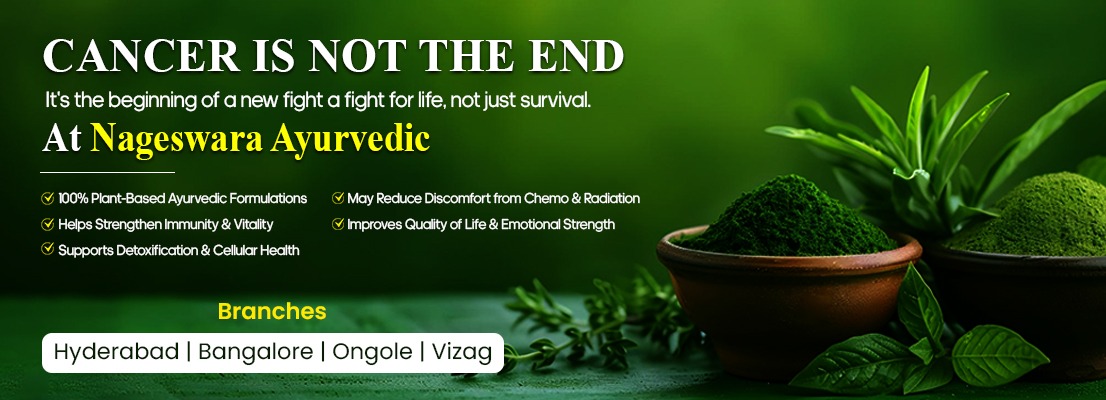
Liver Cancer
Liver cancer occurs when abnormal cells in the liver grow uncontrollably, forming tumors. The most common type is Hepatocellular Carcinoma (HCC), which begins in hepatocytes (the main liver cells). Other types include intrahepatic cholangiocarcinoma and angiosarcoma.
Liver cancer is often associated with chronic liver diseases such as hepatitis, fatty liver disease, and cirrhosis.
Since the liver is a vital organ for detoxification, digestion, and metabolism, its malignancy causes systemic complications.
Causes of Liver Cancer
- Chronic Viral Infections: Hepatitis B virus (HBV), Hepatitis C virus (HCV)
- Alcohol Abuse: Leads to cirrhosis and liver cell damage
- Non-Alcoholic Fatty Liver Disease (NAFLD): Linked to obesity, diabetes, metabolic syndrome
- Aflatoxin Exposure: Toxins from contaminated grains/peanuts
- Liver Cirrhosis: Final common pathway of chronic liver injury
- Genetic & Metabolic Disorders: Hemochromatosis, Wilson’s disease
- Ayurvedic View: Agnimandya (weak digestion) → Ama accumulation → Yakrit dushti (liver impairment) → Raktavaha srotas vitiation → Arbuda formation
Types of Liver Cancer
- Hepatocellular Carcinoma (HCC): Most common, starts in liver cells
- Intrahepatic Cholangiocarcinoma: Starts in bile ducts within liver
- Hepatoblastoma: Rare, occurs in children
- Angiosarcoma: Rare, starts in blood vessels of liver
- Secondary (Metastatic) Liver Cancer: Spread from other organs (colon, pancreas, breast, lungs)
Risk Factors
- Chronic HBV/HCV infection
- Alcohol abuse and cirrhosis
- Obesity, diabetes, fatty liver disease
- Exposure to aflatoxins (contaminated foods)
- Family history of liver cancer
- Smoking
- Long-term use of anabolic steroids
Signs & Symptoms
- Pain or heaviness in upper abdomen (right side)
- Unexplained weight loss and loss of appetite
- Jaundice (yellowing of skin and eyes)
- Ascites (fluid accumulation in abdomen)
- Fatigue and weakness
- Enlarged liver (hepatomegaly)
- Dark urine, pale stools
Complications
- Liver Failure: Impaired detoxification, clotting issues
- Portal Hypertension: Increased pressure in portal vein → variceal bleeding
- Ascites: Severe fluid buildup in abdomen
- Metastasis: Spread to lungs, bones, lymph nodes
- Cachexia: Severe weight loss and muscle wasting
Ayurveda’s Perspective on Liver Cancer
In Ayurveda, liver cancer is linked with Yakrit Vikara, Raktavaha srotas dushti, Granthi, and Arbuda.
1.Nidana (Causes): Ati-madyapana (excess alcohol), Viruddhahara (wrong food), exposure to toxins, chronic anger/stress (Manasika nidana), fatty/oily food excess.
2.Samprapti:
*Agnimandya → Ama production.
*Ama + Pitta-Kapha aggravation affect Raktavaha srotas.
*Yakrit dushti → Granthi formation → Arbuda (malignancy).
3.Dosha Involvement:
*Pitta: Inflammation, jaundice, hepatocyte damage.
*Kapha: Heaviness, tumor growth.
*Vata: Pain, cachexia, weakness.
Lakshana: Yakrit vriddhi (enlarged liver), Peetata (jaundice), Kshaya (wasting), Agnimandya (poor digestion).
Liver Cancer Treatment at Nageswara Ayurvedic – Role of Alocasia cucullata
At Nageswara Ayurvedic, liver cancer care is based on holistic principles of Ayurveda – cleansing toxins, restoring Agni, purifying Rakta dhatu, protecting hepatocytes, and rejuvenating Ojas.
A major focus is on liver detoxification and regeneration, since the liver is the center of metabolism.
Alocasia cucullata (Hastikanda / Chinese taro) is used as a primary Rasayana herb in liver cancer care.
It has been traditionally used in Asia for tumors, liver swelling, jaundice, and chronic infections.
Its rhizome extract contains alkaloids, flavonoids, phenols, and glycosides that have shown hepatoprotective, anticancer, and antioxidant activity in studies.
In cancer care, it supports the destruction of abnormal liver cells (apoptosis induction) while also protecting normal hepatocytes.
It reduces liver inflammation, clears Ama, regulates bile secretion, and restores digestion.
Supporting Herbs
- Bhumyamalaki (Phyllanthus niruri): Protects against viral hepatitis, improves liver enzymes
- Punarnava (Boerhavia diffusa): Reduces ascites and fluid retention
- Katuki (Picrorhiza kurroa): Potent liver detoxifier, reduces fat accumulation
- Haridra (Curcuma longa): Prevents cancer cell proliferation and metastasis
- Guduchi (Tinospora cordifolia): Immunomodulator, reduces chemo/radiation side effects
Together, this protocol suppresses tumor progression, strengthens immunity, and improves liver function.
Alocasia cucullata in Liver Cancer Care
Alocasia cucullata is specifically chosen at Nageswara Ayurvedic for its unique multidimensional activity on the liver and cancer cells:
Anticancer Actions
- Inhibits proliferation of hepatocellular carcinoma (HCC) cells.
- Induces apoptosis (programmed death of cancer cells) without damaging normal liver cells.
- Suppresses angiogenesis (formation of new blood vessels that feed tumors).
Hepatoprotective Effects
- Protects hepatocytes from damage caused by alcohol, viruses, and toxins.
- Enhances antioxidant enzyme activity (superoxide dismutase, catalase) → reduces oxidative stress.
- Prevents further fibrosis and cirrhosis progression.
Anti-inflammatory Properties
- Reduces chronic liver inflammation that drives cancer growth.
- Clears excess Pitta (heat/inflammation) and Kapha (stagnation, tumor mass) from Yakrit.
Metabolic Support
- Improves bile secretion and digestion → restores Agni and nutrient absorption.
- Reduces Ama and supports metabolism of fats, preventing fatty liver progression.
Immunomodulatory Role
- Enhances immune response to detect and destroy cancer cells.
- Prevents recurrent infections in liver cancer patients with low immunity.
Ayurvedic Significance
- Classified as Yakrit Rasayana (hepatoprotective rejuvenator).
- Balances Pitta (inflammation, jaundice) and Kapha (tumor growth, heaviness).
- Strengthens Rakta dhatu and prevents dushti (toxicity in blood).
Treatment Relevance at Nageswara Ayurvedic
The treatment protocol at Nageswara Ayurvedic integrates Alocasia cucullata into a stepwise, patient-tailored regimen for holistic liver cancer management.
Shamana (Pacification)
In the pacification stage, daily administration of herbal formulations is recommended with Alocasia cucullata as the core herb. It is combined with Bhumyamalaki, Punarnava, Katuki, Guduchi, Haridra, and Amalaki to create a synergistic effect. These herbs collectively help shrink tumors, protect hepatocytes, prevent ascites, improve digestion, and enhance overall metabolism.
Rasayana Therapy (Rejuvenation)
As a Rasayana, Alocasia cucullata helps improve Ojas (vital energy) and restores strength. To strengthen this rejuvenation process, plant-based minerals are incorporated:
- Calcium (Cissus Extract): Restores tissue strength and supports regeneration.
- Magnesium (Moringa Leaves Extract): Reduces stress and aids detoxification.
- Iron (Curry Leaves Extract): Boosts hemoglobin and oxygen delivery.
- Zinc (Guava Leaves Extract): Promotes tissue repair and immunity.
- Copper (Sesame Seed Extract): Protects liver cells from oxidative stress.
- Selenium (Mustard Seed Extract): Acts as a potent antioxidant and reduces chemo/radiotherapy-induced liver damage.
- Potassium & Sodium (Moringa and Basil Extracts): Maintain electrolyte balance and metabolic stability.
Diet & Lifestyle
Diet and lifestyle management form an integral part of liver cancer care at Nageswara Ayurvedic. Patients are advised to follow a Laghu Ahara (light diet) consisting of easily digestible foods such as green leafy vegetables, bitter gourd, bottle gourd, turmeric, and millets.
Supportive Role with Modern Treatment
Formulations based on Alocasia cucullata play a supportive role when integrated with conventional treatments such as chemotherapy, radiotherapy, and surgery. They help reduce side effects including nausea, appetite loss, fatigue, and liver toxicity. Additionally, these formulations enhance recovery post-surgery or ablation procedures, improve survival quality, and help prolong life span.
